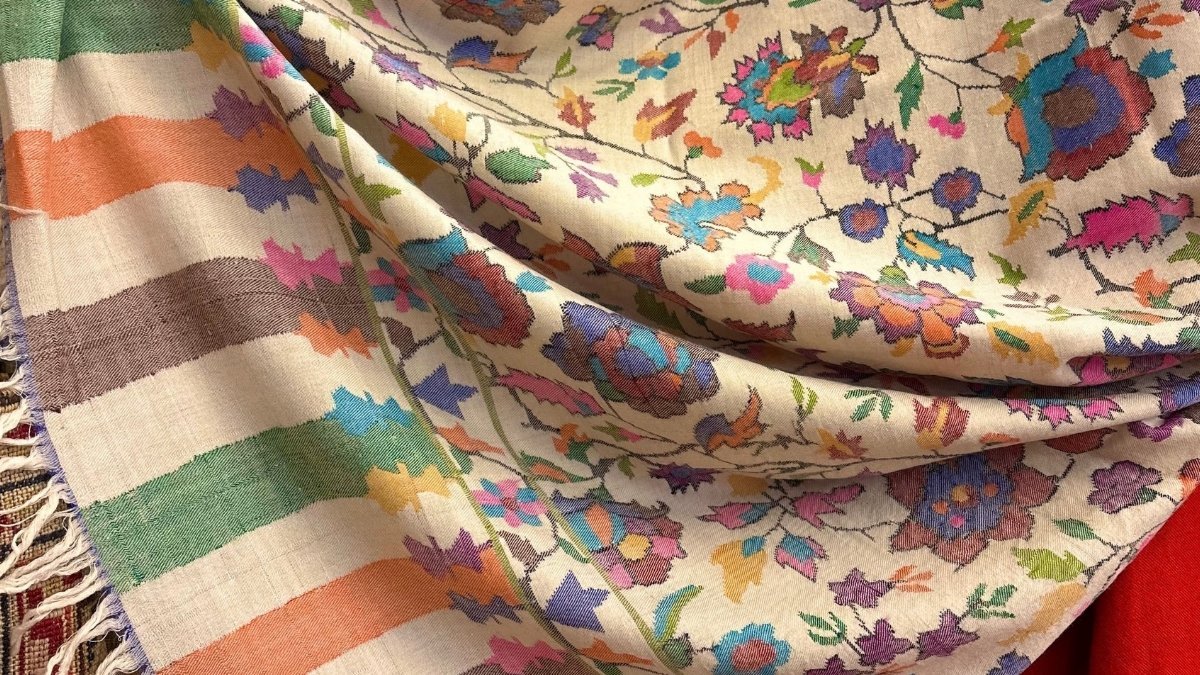
The origin of Pashmina can be traced to the high-altitude regions of Ladakh in India, where the Changthangi goat—also called Capra hircus—produces the fine undercoat that becomes Pashmina wool. The word “Pashmina” comes from the Persian word Pashm, meaning “soft gold” or wool.
Historically, Kashmir became the primary center for Pashmina weaving during the 15th century. It was Sultan Zain-ul-Abidin who introduced the art of weaving Pashmina into elegant shawls, bringing skilled weavers from Central Asia. Later, during the Mughal era, Pashmina shawls became highly coveted royal garments, particularly under Emperor Akbar, who institutionalized their use in the royal wardrobe. These shawls were later exported to Europe and gained popularity in Napoleonic France, turning Pashmina into a global luxury item.
How Pashmina Wool is Harvested from Changthangi Goats in Ladakh
The Changthangi goats, native to the Changthang plateau of Ladakh, grow a soft undercoat to survive sub-zero Himalayan temperatures. The Pashmina wool is not sheared but combed manually during the spring molting season (March–May), ensuring that only the finest fibers—averaging 12–15 microns—are collected. A single goat produces only about 80–170 grams of usable Pashmina per year, which explains its rarity and cost.
The collected wool is called raw Pashm, which is full of impurities like grease, dirt, and guard hair. This raw material is then sent to Kashmir, the traditional weaving center, where it undergoes manual cleaning, carding, spinning, and weaving.
Manual Pashmina Spinning Process: A Dying Art of Kashmiri Women
The cleaned Pashm is spun into yarn using the Charkha (traditional spinning wheel), a practice still predominantly done by Kashmiri women at home. Unlike machine-spun alternatives, this manual spinning produces yarn that is finer and more breathable. It can take up to 15 days to spin enough yarn for a single shawl.
The hand-spun yarn is then passed to master weavers who operate traditional wooden handlooms. Weaving a plain Pashmina shawl takes about 3 weeks, while intricate embroidered shawls like Jamawar or Kani can take months or even years, depending on complexity.
Types of Pashmina Shawls: Kani, Sozni, Tilla and Reversible Styles
Pashmina comes in various types depending on weaving technique and design:
- Kani Shawls: Woven using small wooden sticks (kanis) instead of shuttles. This technique, native to Kanihama village, enables the creation of elaborate patterns. These shawls are often mistaken for printed fabric due to the precision of the weave.
- Sozni Embroidery Shawls: Feature delicate needlework using silk threads. The motifs, usually floral or paisley, are hand-embroidered on the Pashmina fabric by skilled artisans.
- Tilla Shawls: Adorned with metallic thread embroidery, traditionally worn during weddings and special occasions.
- Reversible Pashmina Shawls: Woven in such a way that both sides have usable patterns, ideal for versatile styling.
- Natural and Dyed Pashmina Colors: From Cream to Jewel Tones
Unprocessed Pashmina is typically available in three natural shades—cream, grey, and brown—based on the color of the goat’s fleece. - However, to meet modern aesthetic demands, Pashmina is dyed using natural or azo-free synthetic dyes. Popular colors include midnight blue, ruby red, charcoal black, and ivory white, depending on seasonal fashion trends.
- Dyeing is done after spinning but before weaving, using water from local springs in Kashmir, which is said to enhance dye absorption and fiber softness.
Pashmina vs Cashmere: What’s the Difference?
Although both Pashmina and Cashmere come from the undercoat of goats, the differences lie in:
- Fiber Thickness: Pashmina is finer (12–15 microns) compared to Cashmere (up to 19 microns).
- Geography: Pashmina exclusively comes from Changthangi goats in Ladakh, while Cashmere is sourced from goats in China, Mongolia, and Nepal.
- Processing Method: Pashmina is hand-processed in Kashmir, whereas Cashmere is often machine-processed globally.
- Texture: Pashmina is softer, warmer, and more breathable due to its hand-spun nature.
Ethical Concerns in Pashmina Production: Goat Welfare and Artisan Rights
While Pashmina is a sustainable fiber, ethical concerns persist:
- Goat Welfare: Unsustainable grazing due to increased demand can lead to land degradation in Ladakh. Also, some commercial breeders attempt forced molting, which is harmful.
- Artisan Exploitation: Despite the high global prices, Kashmiri weavers and spinners often earn less than fair wages due to middlemen and lack of formal protections.
- Fake Pashmina Market: The market is flooded with machine-made or viscose-blended shawls falsely labeled as Pashmina, which affects the livelihood of genuine artisans.
- Certifications like GI Tag (Geographical Indication) and Craftmark aim to protect authenticity and ensure fair practices.
Pashmina Maintenance Tips: How to Wash and Store Pashmina Shawls
- Washing: Always opt for dry cleaning. If done at home, use cold water and baby shampoo. Avoid wringing.
- Drying: Lay flat on a towel; avoid direct sunlight.
- Storage: Wrap in muslin cloth and store in a cool, dry place. Use natural moth repellents like neem or lavender sachets.
- Proper care ensures your Pashmina lasts over 30 years, making it a true heirloom.
Pashmina is not just a fabric but a cultural legacy of the Himalayas, a symbol of craftsmanship, and a livelihood source for thousands of artisans. Choosing genuine, ethically-sourced Pashmina supports sustainable fashion and preserves this centuries-old art form.
